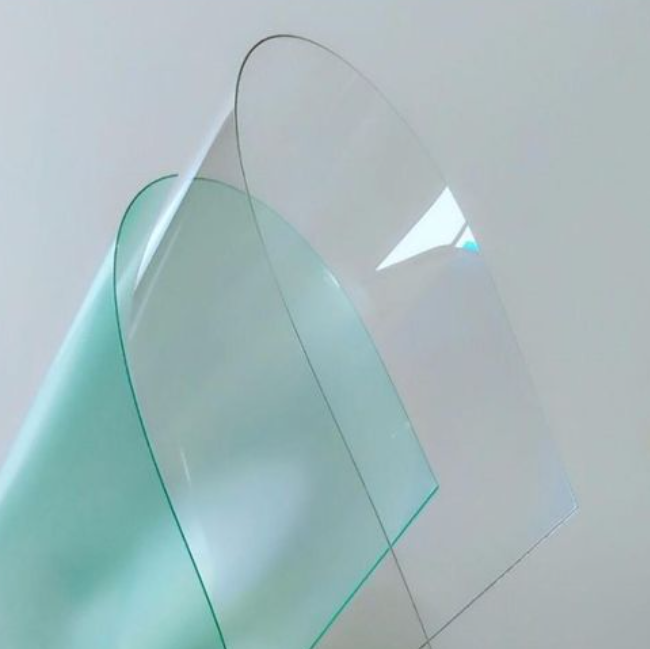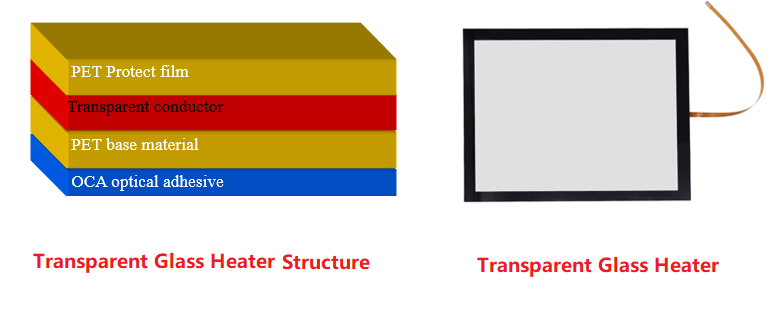Have you ever wondered how car windshields stay clear in freezing weather or how display panels remain fog-free without any visible heating lines? The secret lies in transparent glass heaters — an elegant fusion of clarity and warmth.
Unlike traditional heating elements that block light or leave marks, transparent heaters provide a clear surface that conducts heat evenly across the glass. They’ve become essential in automotive defogging systems, outdoor displays, optical instruments, and even smart windows.
But what exactly makes these heaters transparent? How hot can they get? And what materials help them stay both durable and efficient? Whether you’re an engineer designing a heating system or a buyer comparing options, understanding how transparent glass heaters work will help you choose the right solution for your project.

A transparent glass heater is a type of heating device that integrates a transparent conductive film—commonly indium tin oxide (ITO) or silver nanowire—onto a glass or PET substrate. When current flows through this conductive layer, heat is generated evenly across the surface while maintaining high optical transparency.
These heaters typically achieve light transmittance above 85%, which makes them suitable for screens, lenses, and vehicle glass. Their design provides a fine balance between visual clarity and heating performance. This technology helps eliminate fog or frost quickly without affecting visibility.
The reliability of a transparent glass heater begins with the choice of materials. Each layer contributes to optical clarity, heat uniformity, and structural stability.
1. PET Substrate
The PET substrate serves as the base layer. Commonly used thickness is 0.125mm (including conductive coating). Some designs use 188μm PET, though thinner films are generally avoided due to wrinkling risks that can cause functional defects. PET offers excellent flexibility and high-temperature tolerance, making it ideal for flat or slightly curved applications.
2. PET Protective Film
A protective film shields the heating layer from scratches and environmental damage. The usual thickness is 0.1mm or 0.125mm, chosen according to mechanical strength requirements. This layer maintains clarity while preventing dust accumulation or surface oxidation.
3. OCA Optical Adhesive
OCA (Optically Clear Adhesive) is an optical-grade double-sided adhesive used to bond layers without trapping air. Common thicknesses are 0.125mm or 0.175mm, though exact selection depends on product design and customer requirements. Some applications omit the adhesive layer entirely when direct lamination is preferred.
Here is a transparent heating film structure:

Each of these materials must be selected based on application temperature, transparency goals, and mechanical demands. Even slight variations in layer thickness can affect heat distribution and optical uniformity.
A transparent glass heater typically operates within a temperature range of -40°C to 80°C, it can be used in both cold and moderate heat environments. This range covers most automotive and industrial applications where defogging, anti-frost, or temperature control is needed.
The heater’s thickness usually falls between 0.2mm and 0.4mm, balancing durability with optical transparency. Within this thickness range, the conductive layer can deliver steady heat output while keeping the surface smooth and clear.
For automotive glass or outdoor displays, this temperature capability is sufficient to remove condensation and frost effectively without damaging surrounding components. Engineers can adjust resistance or voltage settings to fine-tune the heating rate, but stability within this -40°C to 80°C range remains the standard benchmark for reliable long-term use.
Yes of course. Transparent glass heaters are widely used for car windshields, rear windows, and mirrors. Their transparent conductive layer clears fog, frost, and condensation while maintaining driver visibility. Unlike traditional wire-grid defoggers, these heaters do not leave visible lines across the glass.
For electric vehicles and luxury cars, they contribute to both aesthetics and comfort. The even heat distribution avoids localized heating, and their fast response time helps improve driving safety in cold or humid environments.
Moreover, modern automotive glass heaters can integrate seamlessly with laminated safety glass. They can be connected through flexible circuits or embedded during lamination to maintain a clean, invisible finish.

A high-quality transparent glass heater has a service life exceeding 30,000 hours under proper conditions. Durability depends mainly on the quality of conductive coating, adhesion between layers, and thermal cycling performance.
Glass-based heaters usually last longer than PET-based ones due to better dimensional stability at high temperatures. However, PET types offer flexibility and are lighter, which suits consumer electronics and portable heating products.
Transparent heating films can be connected in two main ways:
1. Copper Bar Connection
A copper strip is pressed onto the conductive layer, then a wire of the required length is soldered directly onto the copper bar. This method provides strong mechanical adhesion and stable current flow. It’s ideal for products that demand higher current or fixed wiring setups.
2. FPC Ribbon Connection
Alternatively, an FPC (Flexible Printed Circuit) ribbon cable can be bonded to the conductive surface. This type is often made with a plug-in design, allowing customers to connect easily to their control circuit or power source. It offers convenience, consistency, and aesthetic integration for compact designs.
Both methods should use low-temperature solder or conductive adhesive to prevent damaging the transparent conductive layer. The process must maintain uniform contact without obstructing light transmission.
The transparent glass heater price varies depending on several technical and material factors:
To fabricate a transparent glass heater precisely, manufacturers rely on detailed drawings or Gerber files. Below are the essential data customers should provide:
1. Size and Thickness
The overall dimensions and film thickness must be specified. If available, Gerber files or engineering drawings help define layer positions and connection areas accurately.
2. Resistance or Electrical Parameters
Teel us the target resistance value, or specify the working voltage and power with the desired tolerance range. These parameters determine the heater’s heat output and safety.
3. Temperature and Environment
Provide the expected ambient temperature and long-term heating temperature. These details help engineers evaluate whether PET or glass substrate materials are suitable.
4. Adhesive Requirements
State whether adhesive is needed and, if so, the type and thickness of OCA or other bonding layers.
5. Wiring Requirements
Mention if you need the supplier to solder the wire. If yes, specify the wire model, material, and length to match your product design.
Providing complete and accurate data helps us shorten lead time and prevent rework. Danyu electronics is a trusted manufacturer specializing in flexible heaters manufacturing, including transparent heating films, polyimide heaters, custom silicone rubber heaters and thick film heaters. We have rich experienced in this industry and our team are professional that can give you the best solution. If you are interested in transparent glass heater or silicone heaters, you are welcome to reach us at sales@best-heaters.com.
1. What is the main benefit of a transparent glass heater for cars?
It clears fog and frost quickly without blocking visibility, keeping the windshield fully transparent.
2. Can transparent heating films be bent or curved?
Yes, they can be bent into various shapes like flexible circuit boards.
3. How can I control the temperature of a transparent glass heater?
You can integrate temperature sensors or thermostats to regulate power and prevent overheating.
4. What’s the typical transparency level of a transparent glass heater?
Most designs maintain 85–90% light transmittance, sufficient for optical and automotive applications.
5. How do I get a quote for a transparent glass heater?
Provide detailed drawings, target voltage or resistance, adhesive requirements, and wiring details to our online forms or directly email us for an accurate transparent glass heater price.
Simply drop your email or phone number in the contact form, and we'll promptly reply you shortly.